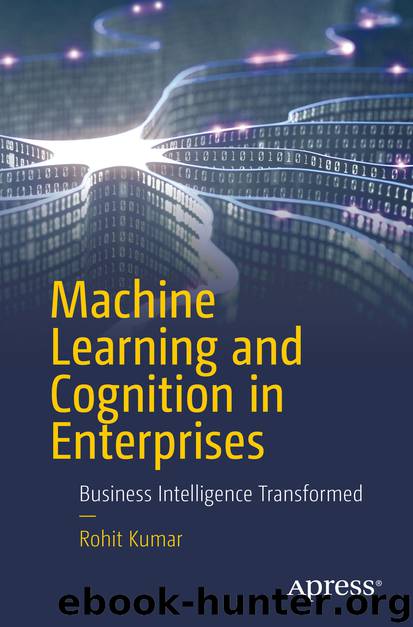Machine Learning and Cognition in Enterprises by Rohit Kumar

Author:Rohit Kumar
Language: eng
Format: epub
Publisher: Apress, Berkeley, CA
Cognitive Work Analysis
Cognitive work analysis (CWA) is an interesting framework for sociotechnological application development. This term was coined by Vicente (1999); it’s a framework which was developed by Rasmussen, Pejtersen, and Goodstein (1994) to analyze cognitive work.
This concept talks about information retrieval by users from systems which are adaptive to the responses as coming in influenced by various internal and external factors. However, the “users” are not considered users but are considered “actors” instead.
What is the differenc e? “User” is more of a static term to which the purpose is prefixed: superuser, admin user, developer user, business user, and so on. So, the way authorizations and roles are assigned to them, they have a limited relevant list of activities that they can perform in the system. As the actions are finite, the way it must be asked to the system irrespective of real scenarios in hand with the user the input and output remains the same. It does not matter if the user is angry or hungry or sleepy or in the mood to do some other undefined activity. The system won’t budge; it will only take designated commands and process the data in steps as relevantly planned into it, because it is limited to serve types of users as defined and limited by rules and configurations in the system.
So, then “context” comes into the picture, and the “actors” act based on current environment and situations they are into and behave accordingly. There could be infinite ways the “actor” can express the same “sentence,” but with a different context.
In the real world, the same person could also express the same sentence or line in a different way as influenced by the situation, work environment, and so on. The behavioral changes of expression cannot be the only attributes considered to decide context; other attributes should be considered as well, or else there is no guarantee that “mental instability” could also be considered as valid (Fidel and Pejtersen 2004). So the focus shouldn’t be just on behavior.
Scientists (Patricia Katopol et al., 2006-2007 http://collab.infoseeking.org/resources/papers/KatopolUIowa.pdf) have come up with multiple other dimensions like work environment, organizational analysis, work domain analysis, task analysis, decision analysis, strategy analysis, and many more. So, the overal l reason for the act by actors should be understood in order to respond intelligently.
Also, it can’t be based just on how most people or such actors react in such a situation; it must be smart enough to analyze th e situation and the reason behind the interactions.
So, considering all the factors that influence an actor within an organization or subject interacting from outside the organization for specific purpose, a context should be reached out and not only via emotional attributes or plain behavioral signatures.
In a nutshell, it could be said that to be able to design a system for a specific purpose, in-depth understanding of the work should be there. The various influences, whether internal to the job or external, should be understood; this will help to design a system (even cognitive) which could provide expected outputs.
Download
This site does not store any files on its server. We only index and link to content provided by other sites. Please contact the content providers to delete copyright contents if any and email us, we'll remove relevant links or contents immediately.
Sass and Compass in Action by Wynn Netherland Nathan Weizenbaum Chris Eppstein Brandon Mathis(7969)
Supercharging Productivity with Trello by Brittany Joiner(7330)
Mastering Tableau 2023 - Fourth Edition by Marleen Meier(7101)
Inkscape by Example by István Szép(6973)
Secrets of the JavaScript Ninja by John Resig Bear Bibeault(6739)
Visualize Complex Processes with Microsoft Visio by David J Parker & Šenaj Lelić(6656)
Build Stunning Real-time VFX with Unreal Engine 5 by Hrishikesh Andurlekar(5682)
Design Made Easy with Inkscape by Christopher Rogers(5002)
Customizing Microsoft Teams by Gopi Kondameda(4544)
Business Intelligence Career Master Plan by Eduardo Chavez & Danny Moncada(4442)
Extending Microsoft Power Apps with Power Apps Component Framework by Danish Naglekar(4154)
Salesforce Platform Enterprise Architecture - Fourth Edition by Andrew Fawcett(4018)
Linux Device Driver Development Cookbook by Rodolfo Giometti(4010)
Pandas Cookbook by Theodore Petrou(4009)
The Tableau Workshop by Sumit Gupta Sylvester Pinto Shweta Sankhe-Savale JC Gillet and Kenneth Michael Cherven(3820)
Exploring Microsoft Excel's Hidden Treasures by David Ringstrom(3295)
TCP IP by Todd Lammle(3119)
Applied Predictive Modeling by Max Kuhn & Kjell Johnson(3006)
Drawing Shortcuts: Developing Quick Drawing Skills Using Today's Technology by Leggitt Jim(2975)
